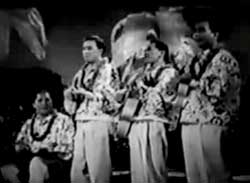 Ray Kinney & His Royal Hawaiian Orchestra with The Aloha Maids star in Ana Lani (1941). The orchestra's decked out in ugly-ass Hawaiian shirts as Ray in a white jacket conducts from beside the piano.
Ray Kinney & His Royal Hawaiian Orchestra with The Aloha Maids star in Ana Lani (1941). The orchestra's decked out in ugly-ass Hawaiian shirts as Ray in a white jacket conducts from beside the piano.
A guitar-strumming male choras begins singing in Hawaiian, & though the Hawaiian swing number ain't one of the best, the harmonizing & the language is cool.
There's a great steel guitar solo. The tastefully traditional dancers, the Aloha Maids, are used more for mood than sexiness & not that much focused upon.
The Aloha Maids were a regular part of Ray Kinney's shows in the 1940s. Ray himself was born in Hilo of Irish-Hawaiian parents, & had an exceedingly long career which began in the 1920s.
He was devoted to popularizing Hawaiian swing music on the continent, & promoting Hawaii as an ideal vactation destination, his goal while he was bandleader of the Hawaiian Ambassadors at Hotel Lexington in New York city, & whenever on tour especially in the west.
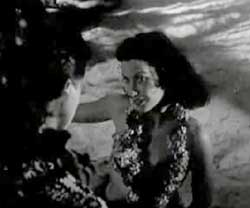 Although the soundie Hawaiian Hula Song (1947) has repeatedly been identified as featuring Ray Kinney, with the dancer supposedly being Ana Lani, these are actually the Kalua Islanders with Maurice and Esme Ash.
Although the soundie Hawaiian Hula Song (1947) has repeatedly been identified as featuring Ray Kinney, with the dancer supposedly being Ana Lani, these are actually the Kalua Islanders with Maurice and Esme Ash.
This soundie was recorded in England. Staged as a moody Hawaiian night, it opens with Esme dancing the hula very seductively as Maurice, accompanying himself on rhythm guita, sings "Au-we Wahine," written by Paul Page.
After an English language introduction in praise of the girl who dances on the beach, it goes into an Hawaiian language lyric, as moodily done as the atmospherics of the night setting. Sitting stage left beside Maurice, on Hawaiian steel guitar, is Ronnie Saunders.
The instrumental that follows the vocals is an up-tempo arrangement of "South Sea Lullabies" to give greater attention to Ronnie Saunders' Hawaiian guitar.
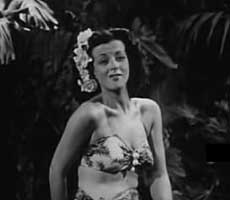 Betty Bradley surrounded by hula girls sings the tropical exotica number The Moon of Manakoora (1945), staged to look like a beach event with a lot of tastefully revealed flesh. Betty's an unusual beauty with a heck of a lot of character in her face.
Betty Bradley surrounded by hula girls sings the tropical exotica number The Moon of Manakoora (1945), staged to look like a beach event with a lot of tastefully revealed flesh. Betty's an unusual beauty with a heck of a lot of character in her face.
The song is from The Hurricane (1937), a film that strongly affected my sexual imagination when i saw it on television as a child. Written by film score specialist Alfred Newman, he really outdid himself as a composer.
Rather oddly (though it's appealing) the camera pans right to a straw hut, & through its door we can see three members of the band, which is Emil Baja & His Orchestra, the rest of the band never being glimpsed.
From out of the straw hut steps Aggie Auld, a leading hula dancer dancer of the 1930s & 1940s, & appears in Hawaii Calls (1938). She has something of the amazon about her, with strength as well as beauty, & a far greater dramatic presence than the other girls in her troupe.
She waves her arms to draw the other dancers away from Betty, almost like a mesmerist. They dance slowly to the laid-back sound of the music & to Betty's singing. Though extremely stagey, it's nevertheless pleasantly evocative, like a Polynesian dream.
At the instrumental break the orchestra throws in a momentary tom-tom rapid beat to give Aggie & her troupe a chance to speed up & show another aspect of their dance skills, though it doesn't really fit the hypnotic qualities of the rest of the performance.
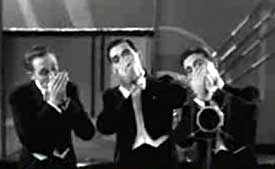 Pathe Films was responsible for scores of "magazine movies," weekly issues seen in film houses of the late 1920s until the first world war, usually focused on unusual novelty acts either comic, musical, or both. They were never credited to specific directors.
Pathe Films was responsible for scores of "magazine movies," weekly issues seen in film houses of the late 1920s until the first world war, usually focused on unusual novelty acts either comic, musical, or both. They were never credited to specific directors.
The Jesters (1934) features the radio pitch-men who sang terrible novelty tunes & told unfunny jokes while selling the horribly named Tastyeast Candybar, I kid you not. They were initially called the Tastyeast Jesters, & pitched the the chocolate flavored yeast with songs on Rudy Vallee's Fleischmann's Yeast Hour.
These three whiter-than-white dudes -- Guy Bonham, Walter Carlson, & Dwight "Red" Latham -- decided to spoof well known radio personalities of the '30s. First up is a bad impression of Bing with lots of bu-bu-boo but no musicality, followed by a swift array of equally pisspoor impersonations. The level of humor reaches it zenith calling Kate Smith "the blimp."
Their "best" bit is "I'll Be Glad When You're Dead You Rascal You" as performed by the Mills Brothers. Although it sounds nothing whatsoever like the Mills Brothers, the mouth-trumpeting of the Jesters is party-positive.
Unbelievably this awful singing team scored a few minor movie cameos to sing silly songs. Continuous radio exposure made it possible to sell novelty tunes direct to the public who managed to find them amusing.
They flourished early enough in the history of commercial "jingles" that singing about products was in itself novel, & the Jesters were part & parcel with the development of jingles. They were still around in the 1940s still making guest appearances in B movies, & made a handful of comedy-song soundies for the visual jukeboxes.
It's hard to imagine anyone actually popping in a dime to watch & listen to them griping in the likes of I Had But Fifty Cents (1945) about a date who ate a big meal they had no way to pay for, or the "korn" hillbilly routine of The Martins & the Coys (1941).
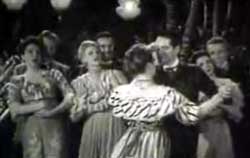 Ray Bloch & His Orchestra back up the Men & Maids of Melody in The Band Played On (1941), which couldn't possibly have gotten much panoram jukebox play when teens & young soldiers were the primary customers.
Ray Bloch & His Orchestra back up the Men & Maids of Melody in The Band Played On (1941), which couldn't possibly have gotten much panoram jukebox play when teens & young soldiers were the primary customers.
The sound is exactly like that of a bunch of singers on Lawrence Welk blurting out a competent but colorless tune together, with no individuality whatsoever.
More interesting than the dreary song drearily sung is the old-timey costomed dancing which the Men & Maids are up to. They're trying to make it look like a Victorian park event. Even that's rather Welky, but still visually more entertaining than the audio.
This awful singing group was the "house chorus" for Minoco Productions which was an in-house Panoram company for making soundies. They appeared in more soundies than any other performers, under a variety of names, four times under this name doing very old public domain songs.
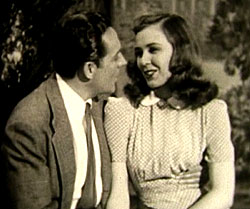 The Men & Maids of Melody are again backed up by the (absent & unseen) Ray Block orchestra, in Apple Blossom Time (1941).
The Men & Maids of Melody are again backed up by the (absent & unseen) Ray Block orchestra, in Apple Blossom Time (1941).
The soundies choral group had a real skill at taking familiar chestnuts & rendering them even more bland than expected.
Here they make an effort to get some "swing" in the arrangement, but they never quite squeeze an update into the Neville Fleeson & Albert Von Tilzer composition, first published in 1920.
There are a lot of members of the group, so they can be arranged all over a stage, this one arranged to appear to be garden. Couples are seated or standing, singing to one another in their Sunday best.
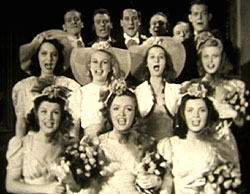 There wasn't much of a budget for torn up paper or a janitor to sweep up, so only a few "apple blossoms" are seen fluttering down into the garden. There wasn't much of a budget for torn up paper or a janitor to sweep up, so only a few "apple blossoms" are seen fluttering down into the garden.
The lyrics include quite a bit about getting married so the scene changes to a bride & her bride's maids hugging & preparing for the strole down the aisle. It comes to a close with all the bridesmaids holding bridal bouquets, presumedly of apple blossoms.
Throughout, with no instrumental break, the chorus keeps on singing en masse, with minimal solo moments.
The song was revived for the 1941 soundie because earlier that year the Andrew Sisters had a hit with a much jazzier harmony version. Many who plopped their dime into a Panoram visual jukebox to hear the recent hit must've been roundly disappointed.
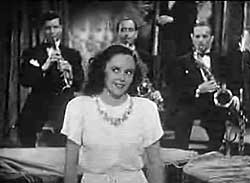 Emil Coleman & His Orchestra is a much more than just competent big band & do a fine version of Gotta Be This or That (1945).
Emil Coleman & His Orchestra is a much more than just competent big band & do a fine version of Gotta Be This or That (1945).
Emil, the fat guy at the piano, waa Russian emigre, had been around since the 1920s with a successful New York band, though not greatly well known outside his narrow stomping grounds.
In the '20s HIS was ragtime band but changed with the times to a tamer swing style, though in the soundie he's arranged a pretty old Broadway song, which had first been introduced in the Ziegfield Follies of 1912.
Less than a minute into this two & a half minute soundie, June Barton strolls out to sing the lyrics. She's really not bad with the lively number. Barton has verve & personality & just a slight girlish quality to her big voice, reminiscent of the young Judy Garland.
The song was written by singer Sunny Skylar, a little squirt of a fellow who recorded his composition earlier in 1945. He'd sung for some of the best bands & had a bit of an independent singing career after the big band era ended & one of his songs, "Besame Mucho," came close to becoming an American standard, but he never really broke out as a big name.
Skylar wrote such clever lyrics that it's fun to actually pay attention to what June's singing: "If it's not full it's blank/ If you don't spend you bank/ If it ain't Bing it's Frank/ It's gotta be this or that."
Through the instrumentals we get lots of close-ups of individual band members. An all round sound little soundie!
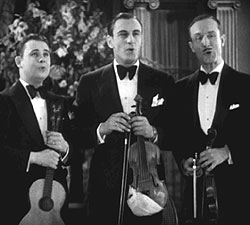 A largely forgotten dance band stars in Gus Arnheim & His Ambassadors (1929), a one-reel Vitaphone soundie.
A largely forgotten dance band stars in Gus Arnheim & His Ambassadors (1929), a one-reel Vitaphone soundie.
The show begins with a rather ordinary orchestration of "I Ain't Got Nobody" but quickly leaps into a jazzier ragtime number with trumbone solo. Gus himself is at his piano dead-center of the orchestra's physical arrangement.
Featured is vocalist & violinist Russ Columbo, who'd been a child prodigy in public performances since the age of twelve. It's a good thing he started young, because by 1934 he'd be dead at age twenty-six.
Rumor was that he was gay & shot himself in the head (in the eye actually). The inquet found that his ten-year companion, photographer Lansing Brown, shot him by accident while attempting a "trick" of lighting a match with the hammer of an antique pistol. Because the vintage mini-ball had ricocheted off an item of furniture, there was no basis for the rumor that it was a lovers' spat, but a genuinely tragic blunder.
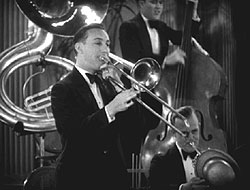 In harmony with two other guys from the orchestra (tenor guitarist & second violin) Russ sings an endearing ragtime number "If I Can't Have You." It runs in part: In harmony with two other guys from the orchestra (tenor guitarist & second violin) Russ sings an endearing ragtime number "If I Can't Have You." It runs in part:
"If I can't have you, nobody but you/ I wanna be lonesome, I wanna be blue./ Wherever I go/ Whatever I do/ I off on my own some/ Just thinking of you..."
It's a great little number & these chaps sing it well. The orchestra takes up the tune anew as an instrumental, & are very charming with it. It's mostly instrumental with several solos built into it. It runs almost exactly three minutes, then the orchestra takes up a second number with the same three guys singing all tenor "Reminds me of You."
This number starts with an eerie bass sax, building the instrumentation to rather generic ragtime. Soon the trio (though the mustachioed third member is replaced by the bass player during the trio vocal this time) begins singing "There's Something About a Rose (That Reminds Me of You)" rather less thrillingly than their first number, coming dangerously close to barber shop for comfort, though still pretty good.
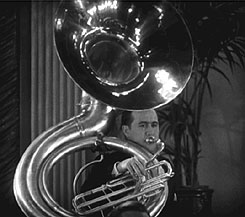 When it returns to being an instrumental the lead instrument is a muted cornet. There'll be a solo for Columbo on violin, the banjoist getting mandolin-musicality out of his banjo, & other good moments if if the instrumental does come off a bit like some 1950s television sit-com themesong. When it returns to being an instrumental the lead instrument is a muted cornet. There'll be a solo for Columbo on violin, the banjoist getting mandolin-musicality out of his banjo, & other good moments if if the instrumental does come off a bit like some 1950s television sit-com themesong.
The orchestra's third number goes back to ragtime which is much more appealing, though it's only a fairly workmanlike arrangement of "Tiger Rag" charming for the enormous tuba doing the roars, & a bit of "Mighty Lak a Rose."
If you've heard someone like Noble Sissle doing this style of music, you know how much better it can be. First-rate seems not to be within the powers of Gus & his Ambassadors. But if there's a highlight, it is indeed Columbo's violin. Fortunately he'd be heard in better orchestras before his short life was done.
Gus's band performed at this time at the Coconut Grove, & were elsewhere billed as The Coconut Grove Ambassadors. The stage is arranged to look like a nightclub's bandstand though it had to have been filmed in the Vitaphone studio as the sound equipment was too clunky to move around with.
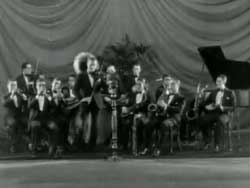 It's still the silent film era when a company called De Forest Phonofilms presented the sound short of the popular dance band Ben Bernie & All the Lads (1924). Nothing antic happens, they just play the music without singers or dancers or even changing seats.
It's still the silent film era when a company called De Forest Phonofilms presented the sound short of the popular dance band Ben Bernie & All the Lads (1924). Nothing antic happens, they just play the music without singers or dancers or even changing seats.
The method was to synchronize a grammaphone recording with the film recording. It worked pretty good for instrumentals but was harder to do with dialogue, so sound for the pre-talkie talkies don't always match up well. So there was a tendency toward using this sound process mainly to show musical events.
The same technology also led to animated films, formerly silent, having all-sung dialogue. When better sound-film processes came along in a short while, it had already become traditional to have cartoons be musical. And Bernie's orchestra has the same style as cartoon soundtracks of the period because that's what roaring twenties hot jazz sounded like.
The band is shown in front of a curtain that sweeps in two directions. Ben Bernie leads the band in an instrumental medley which includes "Rose Marie," "Indian Love Call," "Tea For Two" & "Fascinating Rhythm," giving himself a violin solo immediately before launching into "Tea for Two." The pianist is Oscar Levant.
The medley runs about four minutes, then there's another set at a hair over five minutes, of two music-hall tunes not so well remembered today, "Craving" highlighting Bernie's violin & the muted trumpet, then "Titina" with a great muted trumpet solo, then once more Ben Bernie's violin. Lastly they perform "Sweet Georgia Brown" as basic ragtime, & Jack Pettis provides the first saxophone solo ever recorded on film.
Because Bernie didn't have a record release of "Sweet Georgia Brown" until 1925, some doubt the date of the Phonophone film could be 1924, & never mind that the film has also been dated 1922, the year he founded his orchestra with the name "the lads," & the first year Phonofilms were made.
Because the Gershwin songs & the Ira Berlin song were all published in 1924, it seems the 1922 date is not the least credible, but the 1924 date is entirely probable even with "Sweet Georgia Brown" having been published in 1925.
Publishing arrangements frequently lagged behind performances, intentionally so that popularity could be established beforehand. It is well known that Bernie began performing the number a good long while before it was released on a record, & very likely all the recordings heard on the Phonofilm were recorded at the same time at Vocation, though half of them were released in 1924, the other half held back until 1925 so as not to glut the market.
Written by Macea Pinkard & Kenneth Casey, the Ben Bernie orchestra was the first ever to record what is now a very old standard, so to have it captured on film this early is quite an historic thing, besides sweety done.
The band's popularity caused the song to become so fantastically sought-after as sheet music (in days when every home had a piano in the parlor), Pinkard & Casey decided to add Bernie's name to the sheet music in 1925, so that Bernie could share in the royalties, though he didn't write it at all.
Bernie did it as an instrumental, so it would wait a while yet to be recorded with the words. His band was primarily about instrumentals but one wonders if the insinuating lyrics were thought too risque for his "sophisticated" as opposed to risque jazz band. The number runs about two & a half minutes then the curtain closes.
copyright © by Paghat the Ratgirl
|
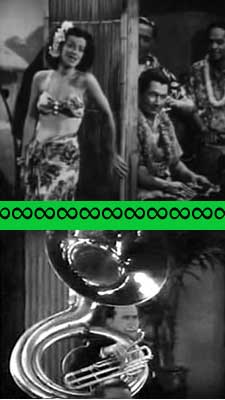






 There wasn't much of a budget for torn up paper or a janitor to sweep up, so only a few "apple blossoms" are seen fluttering down into the garden.
There wasn't much of a budget for torn up paper or a janitor to sweep up, so only a few "apple blossoms" are seen fluttering down into the garden.

 In harmony with two other guys from the orchestra (tenor guitarist & second violin) Russ sings an endearing ragtime number "If I Can't Have You." It runs in part:
In harmony with two other guys from the orchestra (tenor guitarist & second violin) Russ sings an endearing ragtime number "If I Can't Have You." It runs in part: When it returns to being an instrumental the lead instrument is a muted cornet. There'll be a solo for Columbo on violin, the banjoist getting mandolin-musicality out of his banjo, & other good moments if if the instrumental does come off a bit like some 1950s television sit-com themesong.
When it returns to being an instrumental the lead instrument is a muted cornet. There'll be a solo for Columbo on violin, the banjoist getting mandolin-musicality out of his banjo, & other good moments if if the instrumental does come off a bit like some 1950s television sit-com themesong.